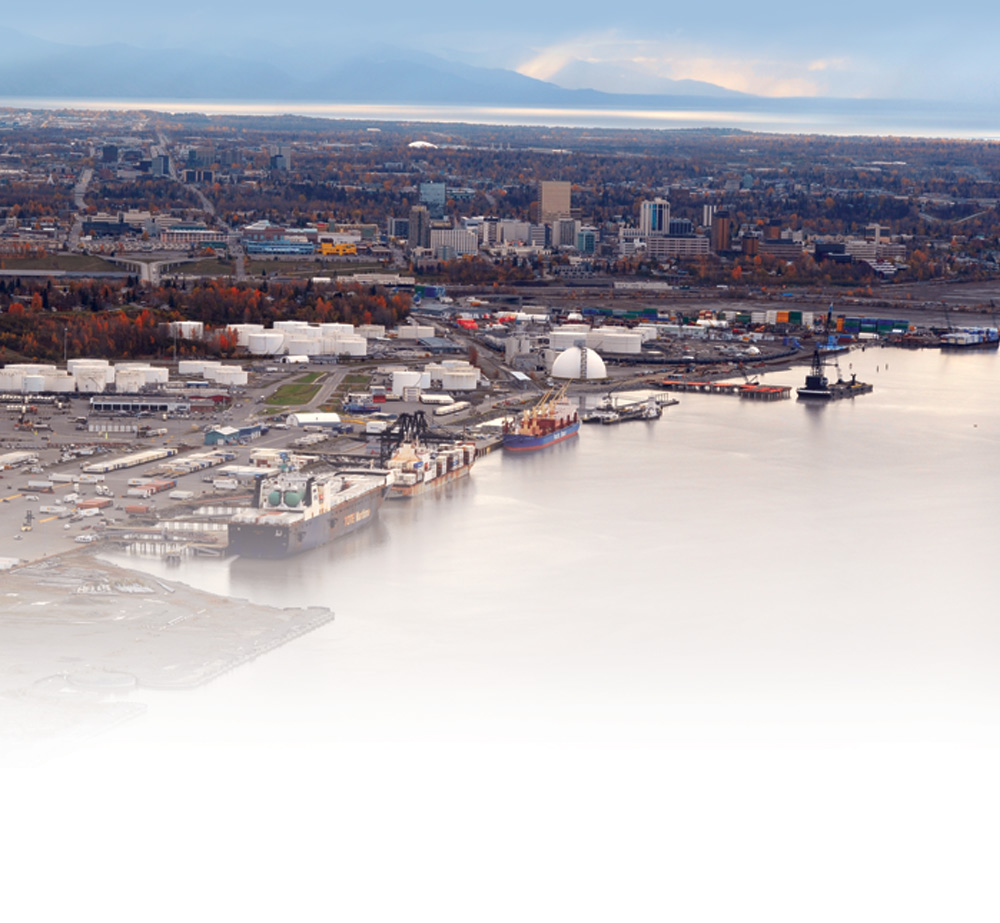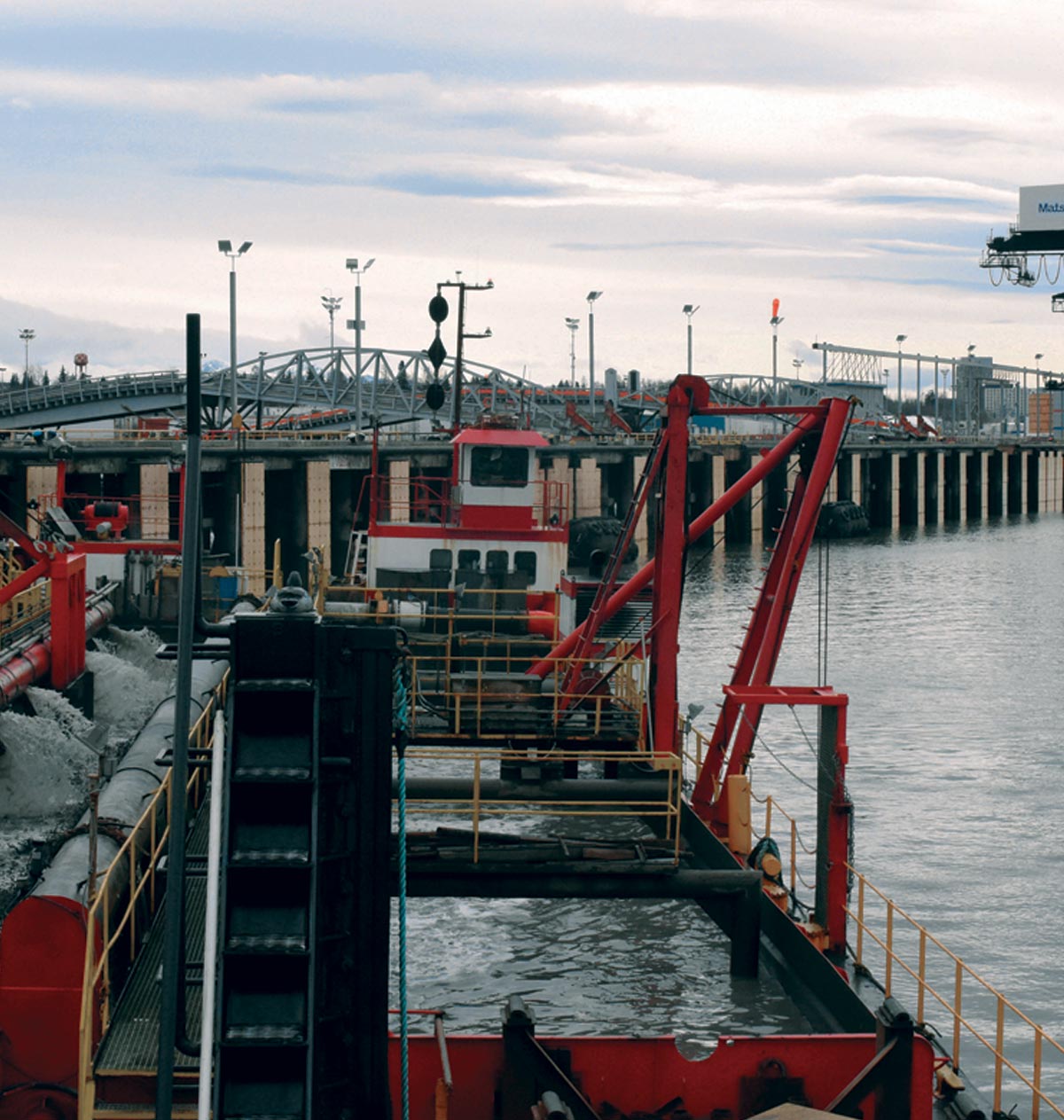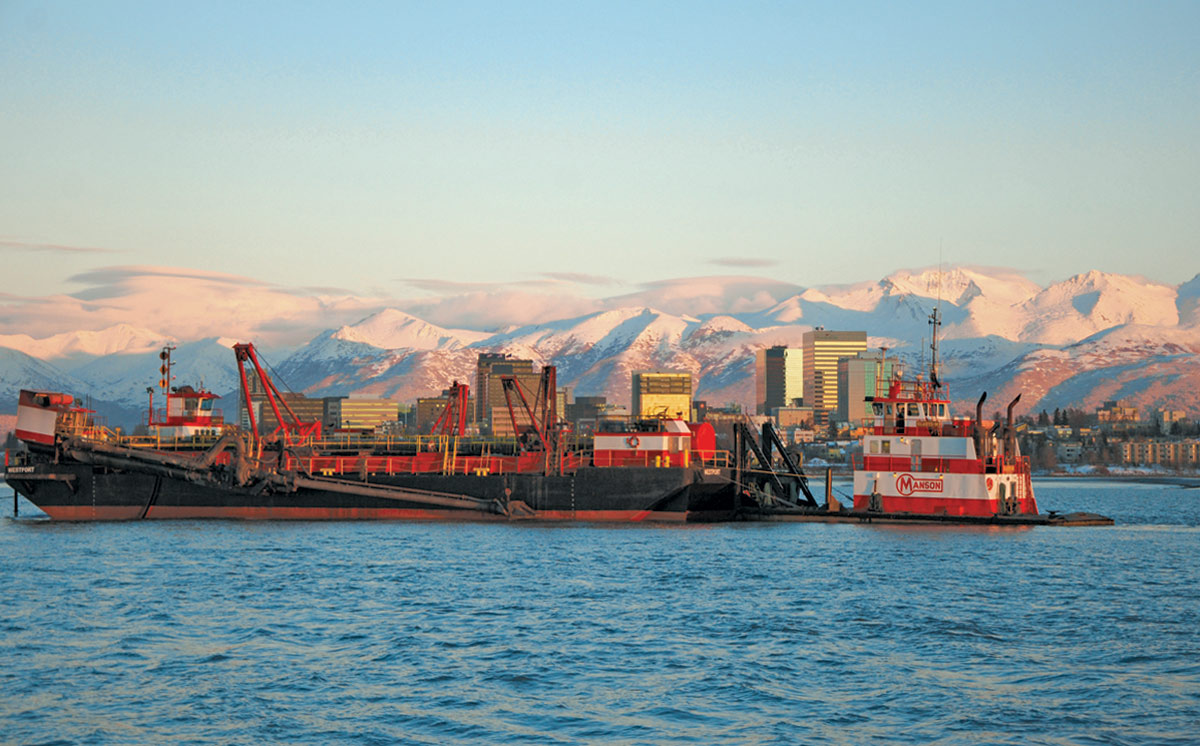
Dredging
Dredging
ut simply, dredging is the excavation of unwanted materials from a marine environment.
But this simple procedure is key to facilitating a variety of more complex processes. From building new docks to maintaining existing ones, dredging is a crucial piece to maritime success.
And for the Port of Alaska, it’s no different.
Recognized as a US Commercial Strategic Seaport by the Department of Defense, it’s the only tsunami-proof, inbound cargo port in all of Southcentral. In 2020 alone, the Port handled more than 4.5 million tons of fuel and cargo. And as Anchorage’s only designated foreign trade zone, it sees its share of traffic.
The Port welcomes everything from fuel tankers to 100-plus passenger cruise ships, facilitating the steady flow of the state’s most important products.
Coordinating the flow of this traffic is “a complete and total dance” according to Jim Jager, the Port’s director of business continuity and external affairs. And one party that the Port coordinates with on a regular basis is Manson Construction Co.—the company that held most of the Port’s maintenance dredging contracts in recent memory, and is again the winner of the latest.
“This port up here is a primary marine cargo handling facility for the state,” says Jeremy Cook, a project manager with Manson. “It’s a very important strategic place. They can’t just have whoever’s going to give them the best price come in here and try to do the work. It’s too critical to play around with. They really need a reputable company that can definitely come in and get the job done—because if not, you know, this is Alaska’s lifeline.”
While the docks belong to the Port of Alaska, Jager explains that because the contract involves federal waterways, the US Army Corps of Engineers is the party responsible for issuing the dredging contract. It is always a competitive process, but with Manson, the USACE has found an able and reliable contractor to serve its needs.
Typically, Manson’s dredge arrives in the Port of Alaska’s waters sometime in April after the ice has cleared up.
“We have to have daily communication with Manson because the dredging all works around our operational schedule,” says Jager. “And during the summer, we’re actually out checking the port on a weekly basis for where the silt is in-filling.”
“Particularly this year, with the Petroleum Cement Terminal construction going on… everybody has work they have to do, so we have to cooperate a lot,” he adds.
As the natural process of sedimentation occurs, sand and silt gradually accumulate in the Port’s channels, creating issues for vessels that need access.
Director of Business Continuity & External Affairs
Port of Alaska
Port of Alaska
Port of Alaska

Manson Construction
Port of Alaska
Port of Alaska

Enter the Westport: a 180-foot, red-and-white hopper dredge, and the brawn behind Manson’s maintenance dredging operation.
Cook compares the machine to a giant vacuum, floating along the surface of the Cook Inlet.
“So basically, the hopper is like the vacuum bag, and it’s where all the material goes. And the drag arm itself is like a vacuum, which is the suction part of it. So material sucks up through the pumps, through the pipes, and into the hopper.”
Manning the 24-hour maintenance dredging operation is a team of four: two people on the tugboat Gladys M, which pushes the Westport, and two people on the dredge itself.
“You have two pieces to this puzzle: the tugboat which controls where the dredge is and where the drag heads go. And then you have the people on the dredge that control the depth of the drag head.”
It takes about three to four hours for the hopper to fill before it’s ready to be dumped, says Cook.
“From there, we take it about a mile away and dump it out in a designated zone,” he continues. “It’s very, very deep and the currents are strong. So the jury is still out if that material ever even reaches the bottom.”
Although the equipment has more or less remained the same through the years, Cook says that there have been some advances made in terms of the technology—particularly in data collection.
“We have a survey boat that goes out and surveys the entire area where we dredge. They go back and forth on these lines collecting data, and the data collection device is basically measuring the distance from the boat down to the sea floor,” he says.
Once the data is collected and the depths are identified, the information is then processed into an electronic map that guides the dredge operators.
“Both pieces of equipment work together to achieve the required depth because the material in-fills in different spots,” says Cook.
“Definitely the tidal swings; 30-foot tidal swings create very strong currents. When you have such a mass amount of water coming in and out, it creates very strong currents that rip through the Port. So trying to operate the dredge with the fast currents is always a challenge.”
Cook also points to the challenges of maneuvering in ice during the early part of dredging season and end of season issues like decreasing daylight and colder temperatures.
Jager adds that the issue of tidal swings is also the reason that Anchorage lacks a harbor—something he’s keen to differentiate between a port.
“A harbor is basically a parking lot where you keep a boat; a port is basically a place where cargo or people moves back and forth,” he explains. “So we don’t have a harbor here because of our 30-foot tides and the silting. For years people have said, ‘Why doesn’t Anchorage have a small boat harbor?’ Well, it’s because we wouldn’t be able to keep it open because of all the dredging.”
He continues: “In a harbor, you purposely slow the water down because you want the boats to be in a nice safe area… but if you’re purposely slowing the water down that’s where all the silt is going to drop out. Pretty soon your harbor won’t be wet—it’ll be a mound.”
Manson Construction Co.
Manson Construction Co.

There’s a multitude of factors that influence the amount of material that’s ultimately dredged in any given year.
“Dredging is an inexact science—it’s more art than science sometimes,” says Jager. “While we average about a million cubic yards of material every year that is dredged out of our ship berths, that varies quite a bit.”
Last year was a heavy dredging year, with Manson’s Westport removing somewhere in the region of 1.2 million cubic yards of material in 2020. And part of the reason, Jager explains, is due to unpredictable weather patterns.
“How much glacial melt you get, the rain you get up on the Matanuska drainage, or the Knik glacier drainage—that all impacts how much silt we get.
“Everybody thinks of glaciers as these great big pieces of ice; they’re really giant earth grinding machines. They grind up lots of rock into fine glacial silt that they dispose of by putting it into the river systems, then the river systems deposit it into Knik Arm, and then the tide moves it back and forth. And where the current slows it down—like where we dock our ships—that’s where the silt drops out.”
The Port of Alaska is currently working with Pacific Pile & Marine on building a new Petroleum and Cement Terminal, as well as performing stabilization work on the port’s North End. Jager is hopeful that by removing some of the sheet pile and restoring the shoreline on the port’s north end, the amount of material that will have to be dredged will be reduced. But the question of exactly how much remains difficult to predict.
“Everybody says that it’s going to reduce the amount of dredging we have to do. Now if you ask them for specific estimates—they’re all over the place,” he says, adding that the predictions have generally fallen within a range of a quarter million cubic yards.
“They all say it’ll be less, but because they’re all focused on slightly different pieces of it, they come up with different numbers,” says Jager.
With something as complex as climate science, there’s always going to be a degree of uncertainty. As for an estimate of how much silt they’re expecting for 2021, Jager says this: “If you ask six different scientists, you’re going to get seven different answers.” ![]()